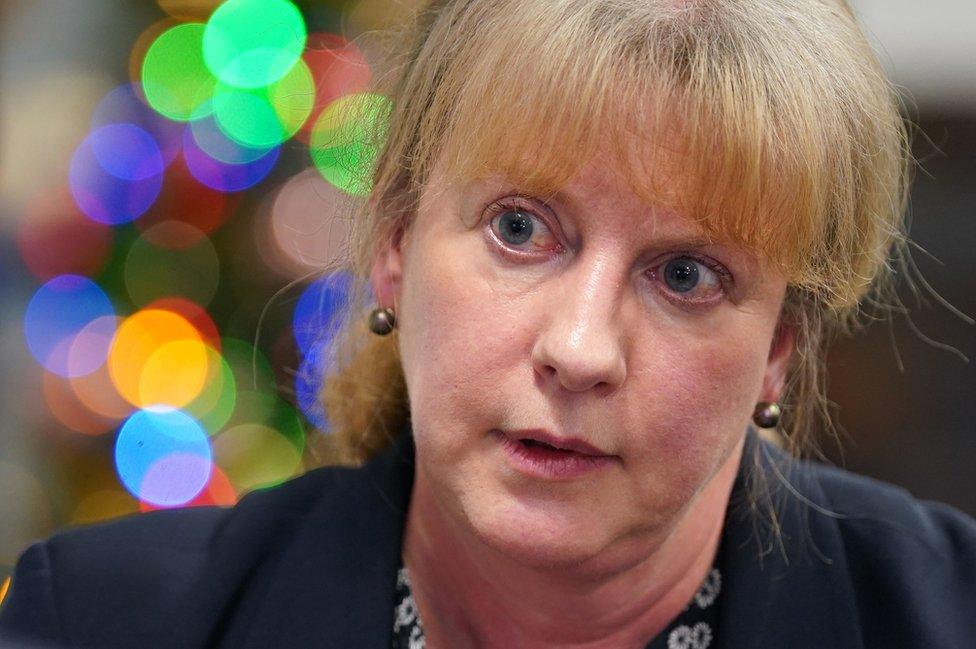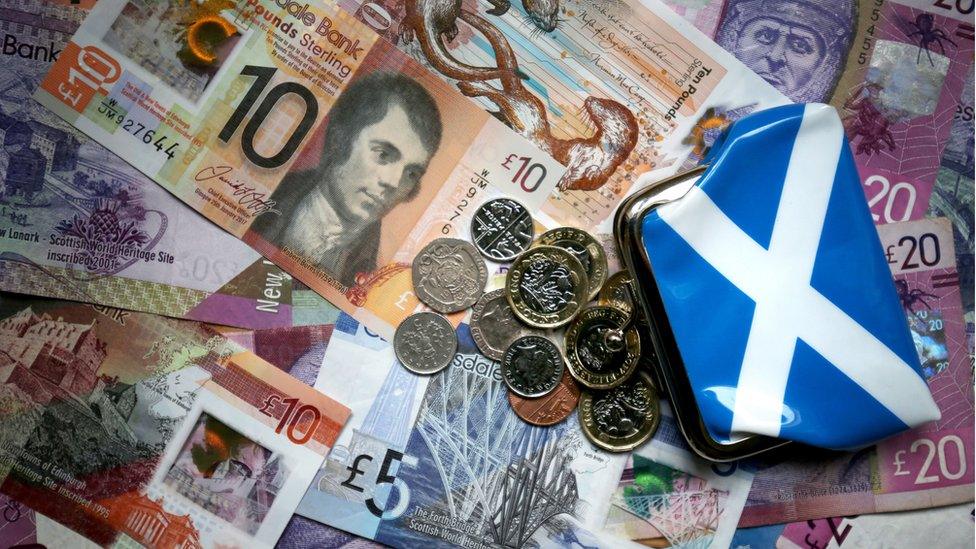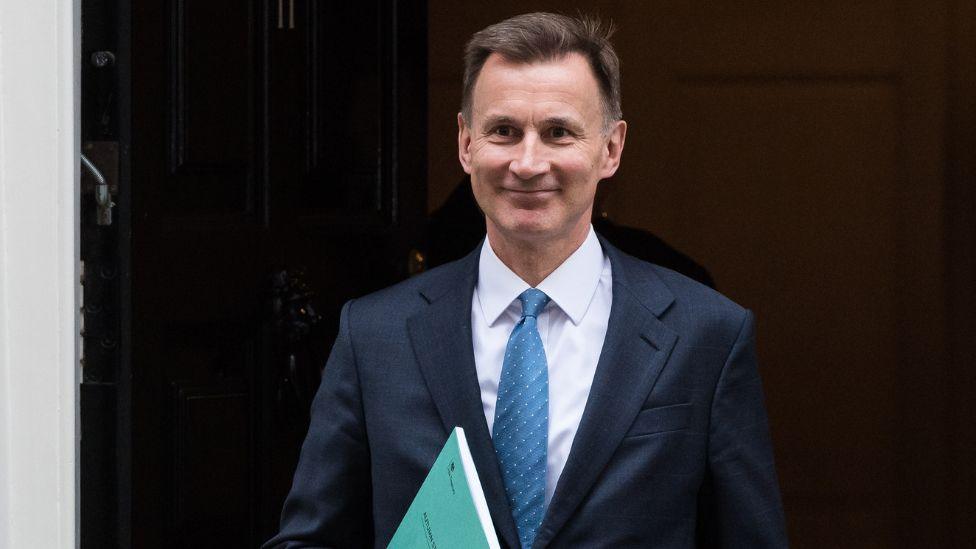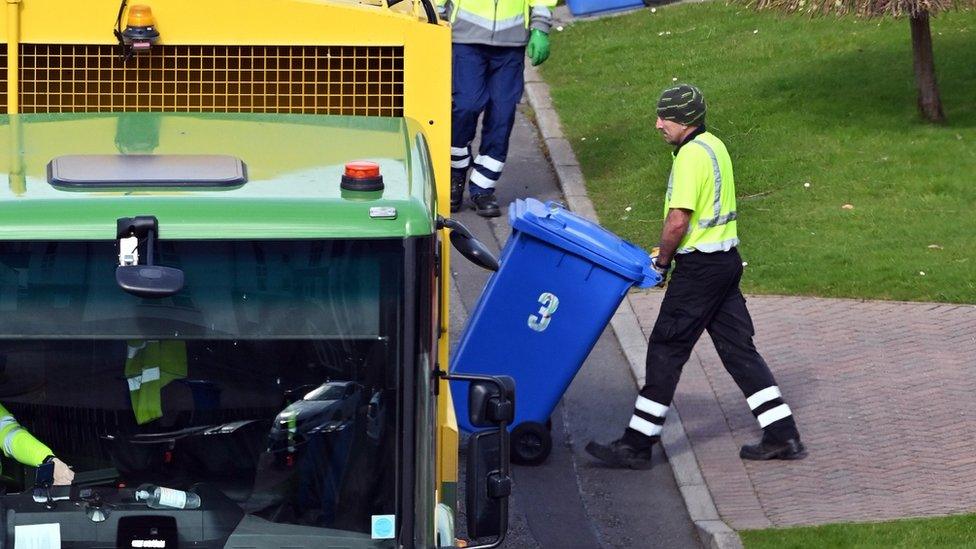How will Scotland plug its £1.5bn budget shortfall?
- Published

Finance secretary Shona Robison must explain how she will fill an estimated £1.5bn hole in Scotland's books when she delivers her £60bn budget later.
Options on the table include tax rises for higher earners, spending cuts for government departments, and public sector job losses.
"The priority," Ms Robison told BBC News, "will be around funding public services."
Visiting RAF Lossiemouth in Moray, Prime Minister Rishi Sunak said Scotland was "already the highest taxed part of the UK," and "it would be very disappointing to see that tax burden continue to rise."
Whatever decisions are taken, this is one of the most difficult budgets since broad powers over domestic affairs, such as health and education, were devolved from London to Edinburgh in 1999.
Since then more than half of the money available to Scotland's devolved government, currently run by the SNP and the Scottish Green Party, has come directly from Westminster in a 'block grant,' which varies annually depending on UK government spending levels and priorities.
In 2016, the Scottish government also gained expanded tax-raising powers, which now include the ability to set income tax rates and bands; business rates; and the property purchase tax formerly known as stamp duty.
However the Scottish finance secretary has only limited powers to borrow, meaning she must present a balanced budget.
There are two parts to that budget: resource spending, which means the day-to-day running of public services, and capital, which involves investment in longer-term projects.

In a strategy document, external published in May, Ms Robison warned that Scotland's financial situation was "amongst the most challenging since devolution".
At that point, the SNP government in Edinburgh was facing an estimated shortfall in resource spending of £1bn and capital of £450m.
Although much has changed since then, the overall shortfall of around £1.5bn remains broadly the same, according to the Fraser of Allander Institute at Strathclyde University.
Why has the shortfall barely changed?
First, inflation has proved persistent, after a sharp rise in prices attributed, variously, to the war in Ukraine, the fallout from the Covid pandemic, and the UK's exit from the European Union.
To a certain extent this has been positive for the Scottish government because it has helped to generate income taxes, external around £970m higher than forecast.
UK Chancellor Jeremy Hunt also benefited from a higher-than-expected tax take.
But if Ms Robison was pinning her hopes on his investing the extra cash in public services, which would have led to an increase in her budget through the block grant, then she was disappointed.
In fact, with a general election in the offing, Mr Hunt used his autumn statement to prioritise two big UK-wide giveaways: cutting national insurance and making permanent a tax break for business investment in machinery and equipment.
While both apply in Scotland, neither makes any difference to the size of the Scottish budget.

Chancellor Jeremy Hunt announced the Autumn Statement in the House of Commons last month
There was, however, an additional £310m for Scotland as a result of the chancellor's decision to provide tax relief to small businesses and to the retail, hospitality and leisure sectors south of the border.
As with the rest of the block grant, Ms Robison can chose whether to spend that cash on the same policies as the UK Conservative government or she can use it elsewhere.
So if the amount of money available to the Scottish government has risen dramatically since the Spring, why is there still a problem?
In part it is because inflation has forced up the costs of running public services but another part of the answer lies in a string of costly promises made by First Minister Humza Yousaf.
He has pushed up welfare payments to tackle poverty, with both the Scottish Child Payment and the Adult Disability Payment (which is replacing the Personal Independence Payment) incurring significant additional costs.
He has authorised pay deals with public sector workers in order to avoid strike action in Scotland. The Fraser of Allander Institute estimates this cost at £500m per year.
Mr Yousaf has pledged to spend an extra £100m per year over the next three years to cut NHS waiting lists.
And at the SNP's autumn conference he stunned Scotland's 32 local authorities by announcing that he was freezing the council tax nationwide.

That means Ms Robison must find funds to make up the shortfall, with the Convention of Scottish Local Authorities (Cosla) looking for at least £300m.
Cosla's resources spokesperson, Councillor Katie Hagmann, says without additional support from Edinburgh, around a quarter of the country's 32 councils are facing the prospect of running out of money for core services.
"Clearly there has been a plethora of cuts already to our library services, to our community facilities," she said, warning "difficult decisions may have to be taken if the budget isn't favourable."
"Every service has been cut in some way over the last decade," agrees Chris Kane, the leader of Labour-run Stirling Council.
"It's horrendous," he said, "you can't sugarcoat it."
Councillor Kane warns that "it would be catastrophic if a council was to fail."
So, where will the Scottish government find the money it needs?
It has a very limited ability to raise some money through borrowing, including potentially by issuing bonds but this would not put a serious dent in the budget.
New tax band
The finance secretary has also been studying proposals on tax made by the Scottish Trades Union Congress (STUC).
At present, according to the Fraser of Allander Institute's pre-budget report, those earning up to £27,800 in Scotland "tend to pay a little less" than they would elsewhere in the UK while earners above that level "tend to pay significantly more".
One option would be a new tax band for earnings between £75,000 and £125,140.
Prof Mairi Spowage, director of the Fraser of Allander Institute, said at 44 pence in the pound such a band would raise around £40m, rising to around £60m at 45p.
Clearly that would not come close to filling the estimated £1.5bn funding gap, leaving open the possibility of significant cuts to public services as well.
The finance secretary would not say where the axe might fall but she has defended the continued existence of universal benefits.

State-funded tuition alone cost an estimated £900m in 2022/23 according to analysis by the Institute for Fiscal Studies, external.
The think tank warns that preserving it will be "increasingly difficult given the financial pressures facing the Scottish government as well as Scottish universities and students."
One way to ease the pressure could be job cuts.
One in five workers in Scotland is employed by the state.
According to Audit Scotland, the devolved public sector workforce amounted to more than 450,000 full-time equivalent roles in 2021/22, costing more than £22bn, external that year.
Ms Robison has repeatedly warned of the need to bring that number down, although she has also promised to negotiate any cuts with the trade unions and to avoid compulsory redundancies.
Still, on the eve of the budget, the finance secretary was signalling that the expansion of the Scottish state might have peaked.
We must, said Ms Robison, "reduce the size of the public sector in an orderly way."